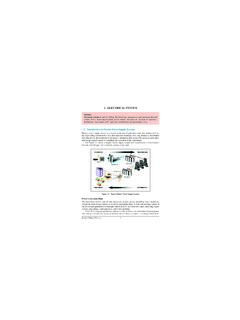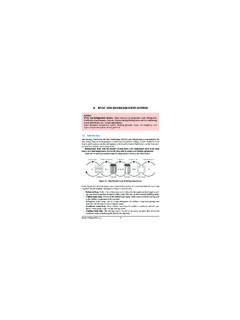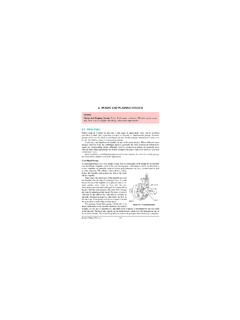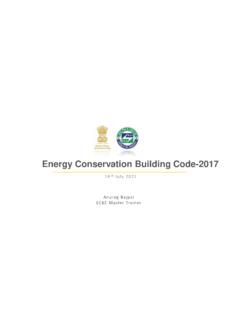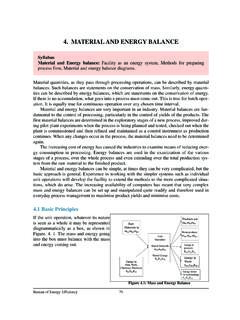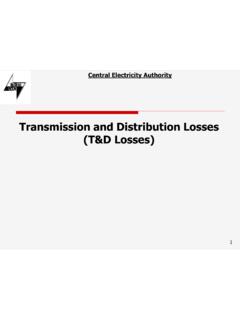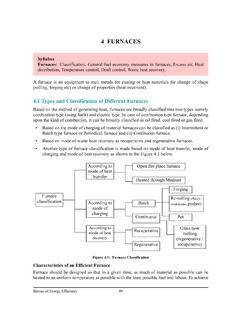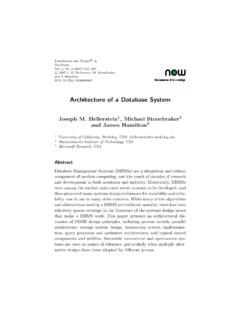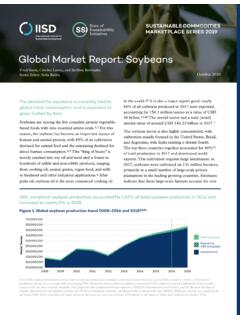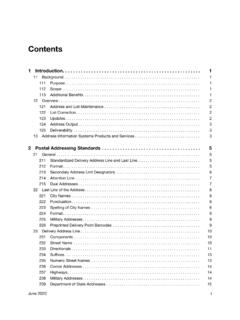Transcription of 8. LIGHTING SYSTEM - Bureau of Energy Efficiency
1 8. LIGHTING SYSTEM153 Bureau of Energy EfficiencySyllabusLighting SYSTEM :Light source, Choice of LIGHTING , Luminance requirements, and Energyconservation IntroductionLighting is an essential service in all the industries. The power consumption by the industriallighting varies between 2 to 10% of the total power depending on the type of and continuous improvement in the field of LIGHTING , has given rise to tremendousenergy saving opportunities in this is an area, which provides a major scope to achieve Energy Efficiency at the designstage, by incorporation of modern Energy efficient lamps, luminaires and gears, apart from goodoperational Basic Terms in LIGHTING SYSTEM and FeaturesLampsLamp is equipment, which produces light.
2 The most commonly used lamps are describedbriefly as follows: Incandescent lamps: Incandescent lamps produce light by means of a filament heated to incandescence bythe flow of electric current through it. The principal parts of an incandescent lamp, alsoknown as GLS (General LIGHTING Service) lamp include the filament, the bulb, the fill gasand the cap. Reflector lamps: Reflector lamps are basically incandescent, provided with a high quality internal mirror, whichfollows exactly the parabolic shape of the lamp. The reflector is resistant to corrosion, thusmaking the lamp maintenance free and output efficient. Gas discharge lamps: The light from a gas discharge lamp is produced by the excitation of gas contained in either atubular or elliptical outer most commonly used discharge lamps are as follows: Fluorescent tube lamps (FTL) Compact Fluorescent Lamps (CFL) Mercury Vapour Lamps Sodium Vapour Lamps Metal Halide LampsLuminaire Luminaire is a device that distributes, filters or transforms the light emitted from one ormore lamps.
3 The luminaire includes, all the parts necessary for fixing and protecting thelamps, except the lamps themselves. In some cases, luminaires also include the necessarycircuit auxiliaries, together with the means for connecting them to the electric supply. Thebasic physical principles used in optical luminaire are reflection, absorption, transmissionand GearThe gears used in the LIGHTING equipment are as follows: Ballast: A current limiting device, to counter negative resistance characteristics of any discharge case of fluorescent lamps, it aids the initial voltage build-up, required for starting. Ignitors: These are used for starting high intensity Metal Halide and Sodium vapour This is the quotient of the illuminous flux incident on an element of the surface at a point ofsurface containing the point, by the area of that LIGHTING level produced by a LIGHTING installation is usually qualified by theilluminance produced on a specified plane.
4 In most cases, this plane is the major planeof the tasks in the interior and is commonly called the working plane. The illuminanceprovided by an installation affects both the performance of the tasks and the appearanceof the (lx)This is the illuminance produced by a luminous flux of one lumen, uniformly distributed overa surface area of one square metre. One lux is equal to one lumen per square Efficacy (lm/W)This is the ratio of luminous flux emitted by a lamp to the power consumed by the lamp. It is areflection of Efficiency of Energy conversion from electricity to light Rendering Index (RI)Is a measure of the degree to which the colours of surfaces illuminated by a given light sourceconfirm to those of the same surfaces under a reference illuminent; suitable allowance havingbeen made for the state of Chromatic Lamp Types and their Features The Table shows the various types of lamp available along with their LIGHTING System154 Bureau of Energy Efficiency8.
5 LIGHTING System155 Bureau of Energy Recommended Illuminance Levels for VariousTasks / Activities / Locations Recommendations on IlluminanceScale of Illuminance:The minimum illuminance for all non-working interiors, has beenmentioned as 20 Lux (as per IS 3646). A factor of approximately the smallest significant difference in subjective effect ofilluminance. Therefore, the following scale of illuminances 30 50 75 100 150 200 300 500 750 1000 1500 2000, .. Lux Illuminance ranges:Because circumstances may be significantly different for differentinteriors used for the same application or for different conditions forthe same kind of activity, a range of illuminances is recommendedfor each type of interior or activity intended of a single value ofilluminance.
6 Each range consists of three successive steps of therecommended scale of illuminances. For working interiors theLumens / WattColorTypical Type of ApplicationLifeIndex(hours)Incandescent8 1814 ExcellentHomes, restaurants,1000general LIGHTING ,emergency lightingFluorescent Lamps46 6050 Good Offices, shops,5000coatinghospitals, homesCompact fluorescent40 7060 Very goodHotels, shops,8000 10000lamps (CFL)homes, officesHigh pressure44 5750 FairGeneral LIGHTING in5000mercury (HPMV)factories, garages,car parking, floodlightingHalogen lamps 18 2420 ExcellentDisplay, flood2000 4000lighting, stadiumexhibition grounds,construction areasHigh pressure sodium 67 12190 FairGeneral lighting6000 12000(HPSV)
7 SONin factories, warehouses, streetlightingLow pressure sodium 101 175150 PoorRoadways, tunnels,6000 12000(LPSV) SOXcanals, street LIGHTING TABLE LUMINOUS PERFORMANCE CHARACTERISTICS OF COMMONLY USED LUMINARIES middle value (R) of each range represents the recommended serviceilluminance that would be used unless one or more of the factorsmentioned below higher value (H) of the range should be used at exceptional cases where lowreflectances or contrasts are present in the task, errors are costly to rectify, visual work is criti-cal, accuracy or higher productivity is of great importance and the visual capacity of the work-er makes it , lower value (L) of the range may be used when reflectances or contrasts areunusually high, speed & accuracy is not important and the task is executed only IlluminationThe following Table gives the recommended illuminance range for different tasks and activitiesfor chemical sector.
8 The values are related to the visual requirements of the task, to user's sat-isfaction, to practical experience and to the need for cost effective use of Energy .(Source IS3646 (Part I) : 1992). For recommended illumination in other sectors, reader may refer Illuminating EngineersSociety Recommendations Handbook/ ChemicalsPetroleum, Chemical and Petrochemical worksExterior walkways, platforms, stairs and ladders 30 50 100 Exterior pump and valve areas 50 100 150 Pump and compressor houses 100 150 200 Process plant with remote control 30 50 100 Process plant requiring occasional manual intervention 50 100 150 Permanently occupied work stations in process plant 150 200 300 Control rooms for process plant 200 300 500 Pharmaceuticals Manufacturer and Fine chemicalsmanufacturerPharmaceutical manufacturerGrinding, granulating, mixing, drying, tableting, s300 500 750terilising, washing.
9 Preparation of solutions, filling,capping, wrapping, hardeningFine chemical manufacturersExterior walkways, platforms, stairs and ladders 30 50 100 Process plant 50 100 150 Fine chemical finishing 300 500 750 Inspection 300 500 750 Soap manufacture General area 200 300 500 Automatic processes 100 200 300 Control panels 200 300 500 Machines 200 300 5008. LIGHTING System156 Bureau of Energy EfficiencyPaint works General 200 300 500 Automatic processes 150 200 300 Control panels 200 300 500 Special batch mixing 500 750 1000 Colour matching 750 100 Methodology of LIGHTING SYSTEM Energy Efficiency StudyA step-by-step approach for assessing Energy Efficiency of LIGHTING SYSTEM is given below:Step 1:Inventorise the LIGHTING SYSTEM elements, & transformers in the facility as perfollowing typical format (Table and ).
10 8. LIGHTING System157 Bureau of Energy EfficiencyS. LightingRating in Watts Population No. of hoursLocationDevice & Lamp & BallastNumbers/ DayBallast TypeTABLE DEVICE RATING, POPULATION AND USE PROFILES. LightingNumbers Meter Provisions AvailableLocationTransformerInstalledVol ts / Amps / kW / EnergyRating (kVA)TABLE LIGHTING TRANSFORMER / RATING AND POPULATION PROFILE:In case of distribution boards (instead of transformers) being available, fuse ratings may beinventorised along the above pattern in place of transformer 2:With the aid of a lux meter, measure and document the lux levels at various plantlocations at working level, as daytime lux and night time lux values alongside the number oflamps "ON" during 3.
